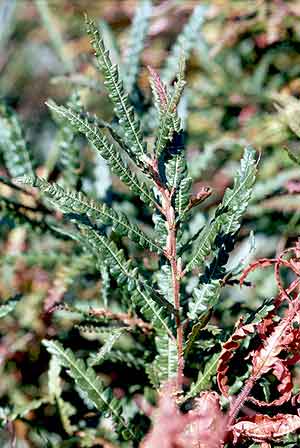 Sweetfern
Sweetfern
Comptonia peregrina
Information from U. Conn.
The dried leaves make an excellent, flavorful and aromatic tea.
Habitat: cold hardy to zone 2; performs poorly in zones warmer than 6; northeastern United States; typically found on gravelly soils along road cuts
Habit and Form: a deciduous shrub 2' to 4' tall with a spread twice the height; a spreading, colonizing plant; stems are slender and upright
Summer Foliage: Alternate deciduous leaves 2 to 4.5 incles long; 0.33 to 0.5 inches wide; elongated linear shape coarse, tooth-like lobes on the leaves young light green matures to a dark green foliage reminiscent of fern fronds foliage fragrant, especially when crushed
Autumn Foliage: green to brown not attractive
Flowers: monoecious, with male and female flowers on the same plant; flowers are small catkins yellow-green color; blooms in April and early may; not ornamentally significant
Fruit: a cluster of small nutlets
Bark: old stems are an interesting copper or purplish color; stems are shiny or with resin dots